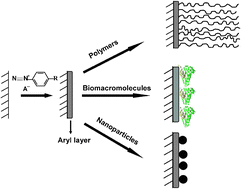Aryl diazonium salts: a new class of coupling agents for bonding polymers, biomacromolecules and nanoparticles to surfaces
Abstract
This critical review summarizes existing knowledge on the use of diazonium salts as a new generation of surface modifiers and coupling agents for binding synthetic


 Please wait while we load your content...
Please wait while we load your content...